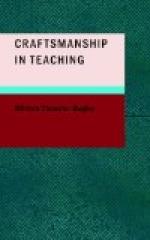What is needed, now that we have got away from the lock step, now that we are happily emancipated from the meaningless thralldom of mechanical repetition and the worship of drill for its own sake—what is needed now is not less drill, but better drill. And this should be the net result of the recent reforms in elementary education. In our first enthusiasm, we threw away the spelling book, poked fun at the multiplication tables, decried basal reading, and relieved ourselves of much wit and sarcasm at the expense of formal grammar. But now we are swinging back to the adequate recognition of the true purpose of drill. And in the wake of this newer conception, we are learning that its drudgery may be lightened and its efficiency heightened by the introduction of a richer content that shall provide a greater variety in the repetitions, insure an adequate motive for effort, and relieve the dead monotony that frequently rendered the older methods so futile. I look forward to the time when to be an efficient drillmaster in this newer sense of the term will be to have reached one of the pinnacles of professional skill.
III
But there is another side of teaching that must be supervised. Although habit is responsible for nine tenths of conduct, the remaining tenth must not be neglected. In situations where habit is not adequate to adjustment, judgment and reflection must come to the rescue, or should come to the rescue. This means that, instead of acting without thought, as in the case of habit, one analyzes the situation and tries to solve it by the application of some fact or principle that has been gained either from one’s own experience or from the experience of others. This is the field in which knowledge comes to its own; and a very important task of education is to fix in the pupils’ minds a number of facts and principles that will be available for application to the situations of later life.
How, then, is the efficiency of instruction (as distinguished from training or habit building) to be tested? Needless to say, an adequate test is impossible from the very nature of the situation. The efficiency of imparting knowledge can be tested only by the effect that this knowledge has upon later conduct; and this, it will be agreed, cannot be accurately determined until the pupil has left the school and is face to face with the problems of real life.
In practice, however, we adopt a more or less effective substitute for the real test—the substitute called the examination. We all know that the ultimate purpose of instruction is not primarily to enable pupils successfully to pass examinations. And yet as long as we teach as though this were the main purpose we might as well believe it to be. Now the examination may be made a very valuable test of the efficiency of instruction if its limitations are fully recognized and if it does not obscure the true purpose of instruction. And if we remember that the true purpose is to impart facts in such a manner that they may not only “stick” in the pupil’s mind, but that they may also be amenable to recall and practical application, and if we set our examination questions with some reference to this requirement, then I believe that we shall find the examination a dependable test.




